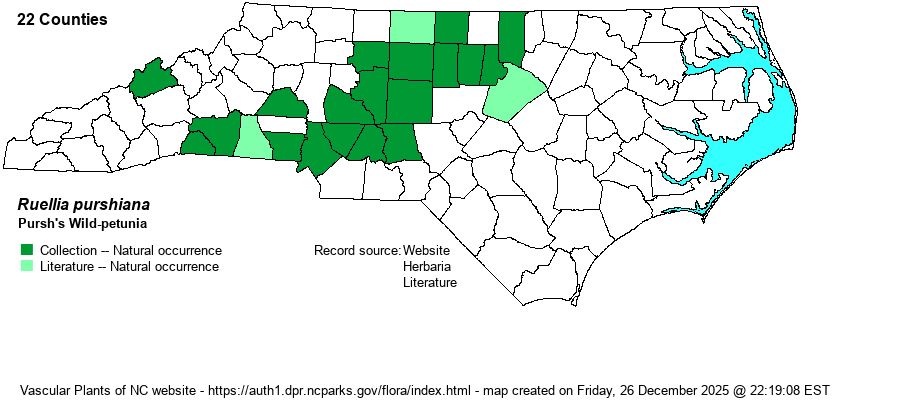| Author | Fernald | |
| Distribution | Occurs in a northeast-southwest band though the east-central part of the Piedmont, and scattered in the southwestern Piedmont; also present in Madison County in the Mountains.
This is a primarily Piedmont species, ranging from MD south to central GA; and it ranges westward only to WV, eastern TN, and AL. | |
| Abundance | Rare to locally uncommon in the east-central Piedmont, and rare in the southwestern Piedmont. Very rare in the central Mountains. This is a Special Concern species. Note the NCNHP's State Rank of S2, the same as given to R. ciliosa, simply is not appropriate. R. purshiana is much more widespread, with several times more records, and thus the website editors rank this species as S2S3 and the other as S1S2. | |
| Habitat | This species is restricted to dry to somewhat mesic, high pH soil in partly shaded conditions. It favors glades and barrens, woodland borders, open woods, and other similar sites. |
| Phenology | Blooms mainly in May, and into June in the mountains. It fruits shortly after flowering. The RAB (1968) listing of flowering dates for this and all species of Ruellia -- "May-Sept." -- is baffling and certainly incorrect. | |
| Identification | This species is rather similar at first glance to the quite common R. caroliniensis. It is an erect, unbranched to sparingly branched, herb growing to about 1.5 feet tall, with a pubescent stem. It has scattered pairs of opposite leaves, ovate to lanceolate, about 3-4 inches long and half as wide, with a short petiole or sessile. In this species, however, the flowers all bloom from lower and middle axils, never at the top or upper axils as in R. caroliniensis. The flowers, generally one per axil, grow on a long stalk about 1-2 inches long; the other species has essentially sessile flowers. The flowers of R. purshiana are somewhat larger and slightly paler than on R. caroliniensis, being about 1.5-2 inches long and often 1.5 inches across at the face, and generally medium lavender in color (and never blue-purple). Though they can grow in the same place, this species always blooms before the common one, usually in May, and should be finished before R. caroliniensis starts flowering. Though R. strepens often blooms from lower and middle axils, that is a taller and smooth plant, with larger leaves; and it grows in rich floodplains or rich forested slopes. Where R. purshiana is found, you can well find several other rare species growing in the same vicinity. | |
| Taxonomic Comments | Some old references used the name R. pedunculata, though RAB (1968) did use R. purshiana.
| |
| Other Common Name(s) | None | |
| State Rank | S2 [S2S3] | |
| Global Rank | G3 | |
| State Status | SC-V | |
| US Status | | |
| USACE-agcp | | |
| USACE-emp | | |

